
How to Play the Game?
The basic principle of the game is simple. Each round, you place your Vikings on the spaces of the action board and take the chosen actions immediately.
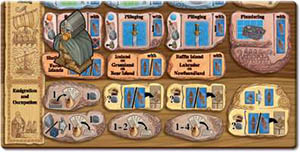
Because each action space can only be occupied once per round, you will quickly get in each other's way.
What you want to achieve?
Your goal is to cover the spaces in the placement area of your home board with green and blue goods tiles. If you leave gaps, you can fill them with ore and silver (as shown below).
To get the goods tiles in the first place, you will either need to obtain them by raiding (in the Viking fashion) or receive them in exchange for farm goods.

This information bar depicts how to place goods in the placement area of your home board. The green and blue color stands for the respective goods.
At any time, you can place tiles, ore tokens and silver coins from your supply onto your home board. Once on your home board, you cannot take them back.
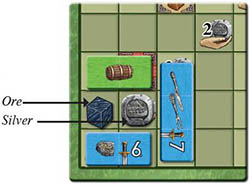
Overseas trading plays a special role in all of this. It allows you to turn any number of different green goods (representing craft products) into blue luxury goods in a single action.
Income
The big numbers across the placement area of your home board represent income values. The smallest visible income value indicates your income for the current round.

The home board on the previous page would generate an income of 2 silver.
Bonus
Some spaces of your home board feature goods symbols.
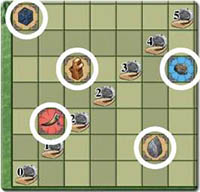
There are five goods spaces on your home board.
You receive these goods each round as a bonus once you have covered all spaces surrounding them.
Sooner or later you may wish to cover the goods spaces to increase your income. (By doing so, you forfeit the bonus).
During the game, you can explore new territories and add them to your home board. You will need ships to do so.
What you get Points for?

At the end of the game, you will add the values of your ships, houses, exploration boards, and goods. Points are indicated by the shield symbol.
Your large ships can increase in for emigration. (Simply turn them value if you use them to the other side when that happens).
After each emigration, you will have one fewer ship at your disposal (here: a longship).
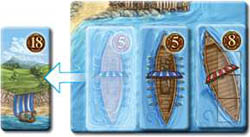
Your home board and the exploration boards have spaces that you must cover with goods tiles to avoid negative points.
The sheds, stone houses, and long houses also have spaces with negative points, which you should cover with goods tiles.
Sheds require wood and stone.
The stone and long houses are special in that they allow you to place orange and red food tiles in them as well as the usual green and blue goods and silver coins, but not ore.
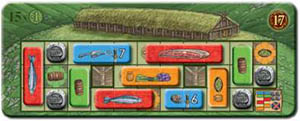
Note the two supporting pillars in the center of the long house: these cannot be covered.
You gain additional points for sheep and cattle, which breed every other round, and for the occupation cards you have played.

The back sides of the animal tiles show pregnant dams.
Continue Reading
